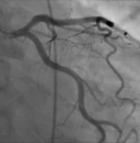The PCI course
|
|
|
Go to the Cardiac catherization course
- Introduction
- Preparation
- Radiation hygiene
- Indications and contra-indications for right sided cardiac catheterization
- Techniques of left sided catheterization
- Coronary anatomy
- Coronary anomalies
- Miscellaneous
- Indications and contra-indications for right sided cardiac catheterization
- Techniques of right sided catheterization
- Anatomy
- Congenital heart disease
|
|
The PCI Textbook
|
|
|
| Browse the illustrated PCI Textbook
a. Atherosclerosis and vascular biology
b. Antiplatlet and antithrombotic agents
c. Other medication
d. Intravascular contrast agents
e. Guiding catheter selection
f. Guidewire selection
g. Embolic protection
h.
a. QCA
b. Intravascular ultrasound
c. Optical coherence tomography
d. Coronary physiology
e.
3. Management of hemodynamic stress
a. Medication
b. IABP
c. IMPELLA
4. Indication for PCI
a. Elective PCI
b. PCI for NSTEMI/ ACS
c. PCI for STEMI
d. Rescue PCI and facilitated PCI
5. Type of PCI
a. Balloon angioplasty
b. Bare metal stents
c. Drug eluting stent
d. Drug elutoing ballon
e. Bioabsorble stent
f. Rotational atherectomy
g. Cutting ballon
h. Directional coronary atherectomy
i. laserangioplasty
6. Type of anatomy
a. Single vessel PCI
b. Ostial lesions
c. Bifurcations
d. Long lesions
e. Diffuse disease
f. Chronic total occlusions
g. Main stem
h. Saphenous vein grafts
7. Management of periprocedural complications
8. Closure devices
9. Late complications
10. Valvuloplasty
a. Ballon valvuloplasty
b. PAVI
c. Mitral valve insufficiency
11. PFO closure
12. Septal ablation
13. Peripheral intervention
|
|
|
|


